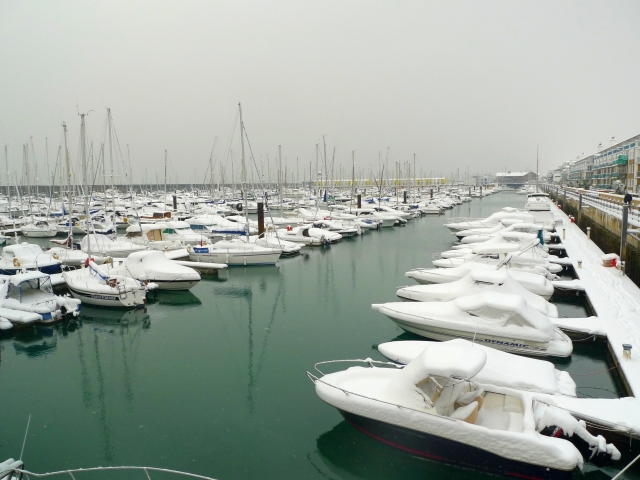Introduction
Winter can be tough on boats. Frost, damp and storms can cause expensive damage if you’re not prepared. Follow these proven steps to protect engines, plumbing, electrics and interiors — and enjoy a fast, hassle-free spring launch. Brighton Boat Sales can help with professional winterisation, dehumidifiers, cover and canopy repairs, and secure storage advice.
1. Engine winterisation — don’t skip the basics
Key steps most yards and pros recommend:
Top up and stabilise fuel — Fill the tank to reduce condensation; use a fuel stabiliser/biocide if fuel will sit for months.
Change engine oil & filter — Old oil contains acids and water; fresh oil protects internal parts.
Flush raw-water cooling and drain or protect with antifreeze — Drain raw-water circuits or circulate marine antifreeze as required by your engine manual.
Fog the engine (where recommended) — Fogging oil coats internal parts to prevent corrosion on petrol engines.
Protect gearboxes and outdrives — Change gear oil and protect seals and up-date your anodes.
(Manufacturer instructions come first; the RYA provide detailed step-by-step winterisation checklists.) Royal Yachting Association+1
2. Onboard plumbing & systems care
Drain freshwater tanks and lines or treat them with marine antifreeze; open taps and drain low points.
Bilge & raw-water strainers — Clean and inspect; ensure sea cocks are clearly labelled and operable.
Heating and air systems — Service diesel heaters and check flues; if you leave systems running set thermostats sensibly to avoid frost damage.
Toilets and waste tanks — Empty and flush systems with a suitable non-toxic antifreeze if recommended by the manufacturer.
(RYA guidance stress removing or protecting anything that can be damaged by freezing.)
3. Electrical systems & batteries
Remove or fully charge batteries and store them in a warm, dry place if possible; use a smart trickle-charger.
Corrosion checks — Inspect terminals, isolators and battery boxes; clean and apply a corrosion inhibitor.
Shore power — If you leave shore power connected, use an RCD/protection system and a quality marine charger.
Failing batteries and corroded connections are common spring problems — proactive maintenance avoids stranded electronics and starting problems.
4. Preventing damp, condensation, mould — dehumidifiers & ventilation
Damp and condensation are the biggest long-term attackers of interiors.
Ventilation first — Keep bilges, lockers and cabins ventilated where practical; trickle vents help.
Use the right dehumidifier — At low temperatures, desiccant dehumidifiers perform better than compressor types; compressors lose efficiency below about 10°C and risk coil frost. For moderately cool conditions, small marine compressor units can still help. Choose a unit designed for unattended, low-temperature marine use and with a plumb-out or drain option for long periods. Yachting Monthly+1
Moisture absorbers (silica/desiccant pots) are a useful backup for lockers and small spaces.
Regular checks — Inspect for early signs of mildew and wipe down wet areas before they set.
(Using a marine-rated dehumidifier designed to run unattended over winter reduces mould risk and protects upholstery, electrics and paperwork.)
5. Covers, canopies and external protection
Inspect covers & tie-downs — Look for chafe, tears and loose fittings before the worst weather arrives. A poorly supported cover will collect water and snow.
Support structure — Ensure cover supports are secure so water/snow sheds away; sagging causes load and pooling. >Nickys Canvasworks
6. Warps, fenders, and deck hardware — small things prevent big problems
Check all warps and mooring lines for chafe and UV degradation; replace any showing core exposure or heavy wear.
Fender condition — Inspect valves, chafe covers and fixings; ensure fenders are correctly placed for tidal/seasonal changes.
Deck hardware & seacocks — Grease moving parts lightly, re-torque cleats and check for water intrusion points. Routine attention avoids lost fenders, broken lines and haul-out surprises. Nickys Chandlery
7. Interiors, upholstery & long-term storage
Remove cushions, sails and soft items where possible; store them dry and off the boat.
Inventory & paperwork — Store important paperwork in dry, sealed containers and take home valuables.
Security & insurance — Confirm your insurance covers winter storage and that your marina/yard rules are met.
8. A simple printable winter checklist (summary)
Fuel: top up & add stabiliser
Engine: oil change, fog if needed, drain/circulate antifreeze in raw-water system
Gearboxes/prop: change oil, check anodes
Plumbing: drain freshwater, toilets, add antifreeze where needed
Batteries: charge/remove/store or fit maintainer
Dehumidifier: install marine-rated unit; set up drain/condensate route
Covers: inspect & reinforce supports; clear pooling points
Warps & fenders: inspect and replace as required
Interior: remove cushions, secure valuables, treat for pests
Documentation: check insurance & marina rules
FAQs
Q: Do I need to winterise if my boat is in a heated shed?
A: If it’s genuinely frost-free and dry, you may not need full winterisation — but batteries, fuel stability and ventilation should still be considered. Check manufacturer guidance.
Q: Which dehumidifier type should I buy for the UK winter?
A: For consistently cold spaces (below ~10°C) a desiccant dehumidifier is usually best; for milder sheltered storage, a compressor marine dehumidifier may be suitable. Always choose marine-rated models for unattended use. Yachting Monthly+1
Why Brighton Boat Sales can help
At Brighton Boat Sales we provide:
Professional engine and system winterisation packages
Assist with supply and installation of marine dehumidifiers suitable for unattended, low-temperature use
Covers and canopy inspection & repair referrals
On-site checks: warps, fenders and mooring condition assessments
Advice on storage options and insurance compliance
Book a winter prep service with Brighton Boat Sales and we’ll make sure your boat sleeps through winter ready to go in spring. Contact us on 07867 303737.

